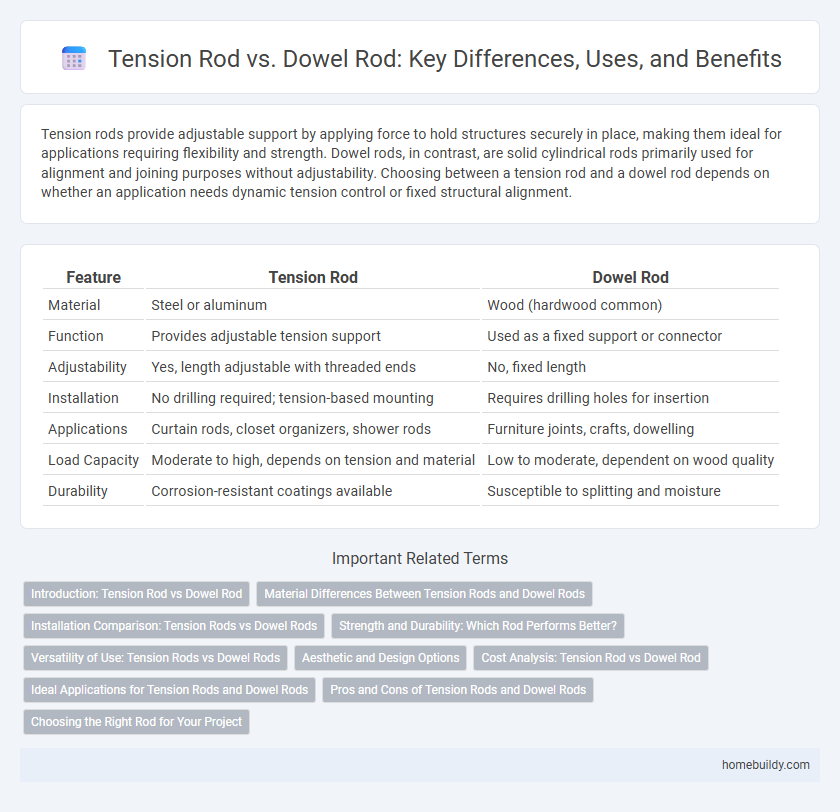Tension rods provide adjustable support by applying force to hold structures securely in place, making them ideal for applications requiring flexibility and strength. Dowel rods, in contrast, are solid cylindrical rods primarily used for alignment and joining purposes without adjustability. Choosing between a tension rod and a dowel rod depends on whether an application needs dynamic tension control or fixed structural alignment.
Table of Comparison
| Feature | Tension Rod | Dowel Rod |
|---|---|---|
| Material | Steel or aluminum | Wood (hardwood common) |
| Function | Provides adjustable tension support | Used as a fixed support or connector |
| Adjustability | Yes, length adjustable with threaded ends | No, fixed length |
| Installation | No drilling required; tension-based mounting | Requires drilling holes for insertion |
| Applications | Curtain rods, closet organizers, shower rods | Furniture joints, crafts, dowelling |
| Load Capacity | Moderate to high, depends on tension and material | Low to moderate, dependent on wood quality |
| Durability | Corrosion-resistant coatings available | Susceptible to splitting and moisture |
Introduction: Tension Rod vs Dowel Rod
Tension rods provide adjustable support in construction and home applications by maintaining consistent tension, making them ideal for securing structures without drilling. Dowel rods are solid, cylindrical wooden or metal rods primarily used for alignment, joining, or reinforcing joints in woodworking and furniture making. While tension rods offer flexibility and easy installation, dowel rods provide rigid, fixed support with less adaptability.
Material Differences Between Tension Rods and Dowel Rods
Tension rods are typically made from high-strength steel or stainless steel, offering superior tensile strength and durability compared to dowel rods, which are commonly crafted from wood or lighter metals such as aluminum. The steel composition of tension rods allows them to withstand significant tension forces in structural applications, whereas dowel rods provide limited load-bearing capacity and are often used for alignment or lightweight support. Material differences impact corrosion resistance, with stainless steel tension rods being more suitable for outdoor or high-moisture environments than wooden or aluminum dowel rods.
Installation Comparison: Tension Rods vs Dowel Rods
Tension rods install quickly with a spring-loaded mechanism that requires no hardware or drilling, making them ideal for temporary or adjustable setups. Dowel rods necessitate precise measurement and mounting brackets or drilled holes, resulting in a more permanent and stable installation. The ease of installation with tension rods significantly reduces labor time compared to the more involved process required for dowel rods.
Strength and Durability: Which Rod Performs Better?
Tension rods typically outperform dowel rods in strength and durability due to their design, which allows them to withstand greater tensile forces without bending or breaking. Made from high-tensile materials like steel or aluminum, tension rods resist deformation and maintain structural integrity under heavy loads, unlike dowel rods that are often made from wood or softer materials prone to splitting. For applications requiring long-lasting support and resistance to stress, tension rods provide superior performance compared to dowel rods.
Versatility of Use: Tension Rods vs Dowel Rods
Tension rods offer greater versatility of use compared to dowel rods due to their adjustable length and ability to create tension between two surfaces without permanent fixtures. Unlike fixed-length dowel rods primarily used for alignment or structural support, tension rods can be adapted for hanging curtains, organizing spaces, or providing temporary support in various settings. Their flexible application makes tension rods suitable for both decorative and functional purposes across home and industrial environments.
Aesthetic and Design Options
Tension rods offer sleek, minimalist aesthetics with adjustable lengths that blend seamlessly into modern interiors, providing versatile installation without visible hardware. Dowel rods, typically fixed and less adjustable, have a more traditional appearance often requiring additional brackets, limiting design flexibility. Choosing tension rods enhances clean lines and customization in window treatments or room dividers, aligning with contemporary design trends.
Cost Analysis: Tension Rod vs Dowel Rod
Tension rods generally offer a more cost-effective solution compared to dowel rods due to their simpler installation process and lower material expenses, especially in large-scale construction projects. Dowels tend to be more expensive because of higher manufacturing costs and the need for precise alignment and fitting. When evaluating project budgets, tension rods reduce labor costs and material wastage, making them a preferred choice for cost-sensitive applications.
Ideal Applications for Tension Rods and Dowel Rods
Tension rods excel in applications requiring adjustable support and the ability to withstand tensile forces, such as securing shelves, curtains, or framing structures where flexibility and load tension are critical. Dowel rods are ideal for precise alignment, joinery, and structural reinforcement in woodworking and cabinetry, providing rigid, fixed connections without the need for tension adjustment. Choosing tension rods suits scenarios demanding dynamic load handling, while dowel rods fit static, load-bearing joints requiring stability and exact positioning.
Pros and Cons of Tension Rods and Dowel Rods
Tension rods offer easy adjustability and strong support without the need for permanent hardware, making them ideal for temporary or damage-free installations, but they may lack the rigidity and load-bearing capacity of dowel rods. Dowel rods provide superior durability and fixed structural strength through solid wood or metal construction, yet they require precise installation and can cause surface damage due to their permanent fixtures. Choosing between tension rods and dowel rods depends on the balance between flexibility and permanence in applications such as curtain hanging, closet organization, or crafting.
Choosing the Right Rod for Your Project
Tension rods provide adjustable strength and flexibility, making them ideal for framing and support applications requiring precise tension control. Dowel rods, typically made from wood, excel in fixed-joint woodworking tasks where rigidity and alignment are crucial. Selecting the right rod depends on project demands: use tension rods for dynamic loads and adjustability, while dowel rods suit static structures needing stable, permanent joints.
tension rod vs dowel rod Infographic

 homebuildy.com
homebuildy.com